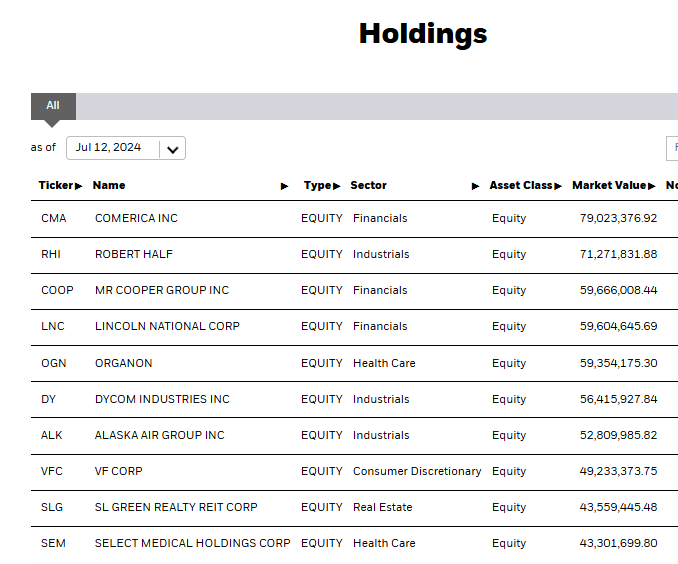Small-caps have been on a tear since the 2nd week of July this year, and it looks like there’s potential for a long-term secular shift towards outperformance in this part of the marketplace. I’d much rather prefer small to large in the years ahead, and if you’re of the same mindset, you may want to consider the iShares S&P Small-Cap 600 Value ETF (NYSEARCA:IJS).
This is a passive fund that tries to track the S&P SmallCap 600 Value Index, which consists of US small-cap equities that the market perceives as being cheap compared to their peers on grounds such as price-to-earnings, price-to-book, and price-to-cash flow. Originally started in July 2000, IJS has a sizable asset base of more than $6.8 billion, at a relatively low expense ratio of just 0.18%.
A Look At The Holdings
The fund currently has 479 holdings, with an overall portfolio P/E ratio of 14.97 and Price to Book of 1.28. No position makes up more than 1.18% of the portfolio, making this a very well diversified fund overall that, candidly, is due to show some real momentum in my view.
ishares.com
What do some of these companies do? Comerica Incorporated provides commercial banking services, primarily in Texas and Michigan, as well as in California, Florida, and Arizona. Robert Half International Inc. offers temporary and permanent professional staffing and consulting services to the financial services, accounting, and technology marketplace. Lincoln National Corporation is a large insurance and retirement services provider specializing in annuities and life insurance products. And Organon & Co. is a pharmaceutical company that operates in women’s health and develops biosimilar products.
Sector Composition and Weightings
Value tends to be dominated by Financials, Industrials, and Consumer Discretionary as the top sectors. That’s precisely what we see here, with Financials making up a little over a quarter of the fund. Notice that Tech comes in at 4th place in terms of overall weighting. If you’re bearish on large-cap Tech, this is a good way to minimize the role the sector can have on an overall portfolio.
ishares.com
I am bullish on Financials broadly. I think we’re way past the regional bank crisis of last year, and if the Fed cuts rates, it will help duration holdings, which have gotten so badly hit in the last cycle of Fed hiking.
Peer Comparison
One good fund worth comparing IJS to is the iShares Russell 2000 Value ETF (IWN). This fund tracks the Russell 2000 Value Index, which measures the performance of US small-cap value stocks. That index tends to have more smaller-cap stocks than IJS, making it more volatile because of that exposure. When we look at the price ratio of IJS to IWN, we find that IJS has underperformed since 2023. Much of this may be due to differences in regional bank exposure between the two funds, as that ratio peak was just around the time the regional bank crisis took place. Aside from that, the funds relative to each other have gone nowhere since 2019.
stockcharts.com
Pros and Cons
On the plus side, the fund provides investor exposure to underappreciated companies in a part of the market that is often overlooked by institutional money managers, especially pension funds. The value tilt on small-cap stocks, where both that style of investing and market-cap range have been ignored, make this an interesting fund to consider from a mean reversion standpoint. There’s a lot of potential for this to run, in my view.
But that potential upside comes with both risks. Small-caps are typically more volatile and more susceptible to forces of economic negativity because they don’t have the same financial firepower or diversification enjoyed by larger firms. In addition, the value-oriented investment strategy of IJS requires that the index correctly identify companies that are undervalued – a challenge in any given market environment, let alone a rapidly changing one.
Conclusion
Overall? I think the iShares S&P Small-Cap 600 Value ETF is actually really attractive here. It hasn’t done all that much performance wise in 2024, and if large-cap Tech momentum is near its end, this could be a rotational beneficiary. I would certainly consider this from a buy and hold perspective here, and think it may have a far more attractive future return stream than just buying the core S&P 500.
Are you tired of being a passive investor and ready to take control of your financial future? Introducing The Lead-Lag Report, an award-winning research tool designed to give you a competitive edge.
The Lead-Lag Report is your daily source for identifying risk triggers, uncovering high yield ideas, and gaining valuable macro observations. Stay ahead of the game with crucial insights into leaders, laggards, and everything in between.
Go from risk-on to risk-off with ease and confidence. Get 50% off for a limited time by visiting https://seekingalpha.com/affiliate_link/leadlag50percentoff.
Read the full article here




